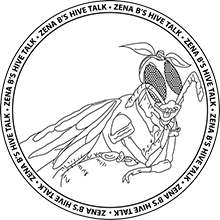Hive Talk - March 2020
March 2020 - Zena Bee’s Hive Talk

March 2020 - Zena Bee’s Hive Talk
Obituary Notice - South and Middle Hive. North Hive is still alive.
Much to my dismay when we went out to give the bees some food at the end of February, we discovered that two out of 3 hives were dead-outs! Two hives were frozen solid! This happened sometime between my January report and now. How disappointing! However, this is giving me the opportunity to learn the “whys'' of their demise. Poor beebies!
Some of my ideas around why the hives died were: Poisoning - No, I inspected several piles of dead bees to see if their little tongues were protruding as this would indicate. During the summer when they are foraging, some farmers will use a type of spray that is not good for the foraging honeybee. Starvation - No, when I opened up the hives and inspected the frames with its dead occupants, the indication of starvation was not there. (I learned this last year when one of my hives died. All of the bees were head first in the cells, dead). The two hives, this year, had LOTS of honey in the frames. Varroa Mite - No, when I did a mite count in the fall, it was exceptionally low, or non existent. The type of bee that I have, “Saskatraz” had the unique ability to resist, or keep a low count of the mites through their hygienic behaviour. There were no disfiguring of the bees that would indicate mite infestation as the mites will feed on the larvae as they are developing in their cells. European and American Foulbrood - No, indication of this nasty, deadly, and VERY contagious condition present. If I had this in my hives I would have to incinerate everything and start from scratch. Had I been a close neighbour to another beekeeper, I would notify them so that they could take preventive measures to stop the spread. This is the worst case scenario! I am also registered with the Province. If I have ‘foulbrood’ I would report it and have a government inspector come out to verify that it is a foulbrood condition. Chalk Brood - No indication of this as it appears as it sounds. It is treatable. Mould - There was some mould on the inside of the hive walls indicating a higher than tolerated amount of moisture in the hives. I did install absorbent material in the top chamber to handle excess moisture, but perhaps should have drilled little vents in the top of the hive box to help ventilate the hives. I have since bleached the hive boxes. Death of the queen - interestingly the cluster of bees that I referred to in earlier “Hive Talks” was not apparent. The bees seemed to be scattered among the hive and not in one location. They were not clustered together to keep each other warm. Total colony collapse, perhaps? There were also drones present, they should have been kicked out prior to winter. Did I insulate the hives properly? Well, yes, but no. Let me explain...we wrapped each hive with an insulated layer much like a puffy coat you would wear during the winter time. We then wrapped the whole hive structures (all three) in an insulated tarp for a windbreak. That looked good however, when I assembled the hives in the spring I installed a ‘screened’ bottom board. It is the first part of the hives structure that you set down on a raised platform (like pallets) before the brood boxes. The screened bottom board allows air flow, and an opportunity to slide a sticky board in the bottom to see if you have any mites, or other insects visiting your hivel The insects would drop through the screen onto the ‘indicating’ sticky paper.
Since the discovery of my dead colonies, and after deliberation in the many bee books that I have, I have come to the conclusion that I should have replaced the screened board with a solid bottom board.
The frames with honey in them were frozen.
There was an indication of mould which wouldn’t help with keeping the hive dry and prevent the moisture from freezing.
The opening in the bottom of the hive due to the screened board. It would be like leaving the door open at home and letting the frigid cold in. (note; I left a screened board in one of the hives last year, and it survived. This is another excellent trait of the “Saskatraz bee”. But, didn’t work this year)
So many things to think about when you're a beekeeper. Continually learning about keeping their health intact. Learning about different methods of feeding, medicating, controlling swarms, preventing ‘dead-outs’. And so much more,
I definitely do not claim to be an expert, by no means, but I am enjoying the time I have with the girls.
And yes, I have two nucs on order for mid-May. (That’s approximately 10,000, or 3 lbs. of bees in each nuc, plus her Majesty!) Hope they bee-have in the car on the ride home!
Until next month, Bee Kind to one another and stay safe!
ZenaB’s Raw Honey zenabshoney.com 1-306-679-2207
